In the mid-50s, the US Navy decided to enter the ballistic missile game. Initially, they were to cooperate with the Army on the Jupiter missile, but this was quickly abandoned in favor of a new missile, known as Polaris. The Special Projects Office, led by Admiral William Raborn, took Polaris from paper studies to deployment in only four years, with the submarine USS George Washington taking the first missiles to sea in November 1960.
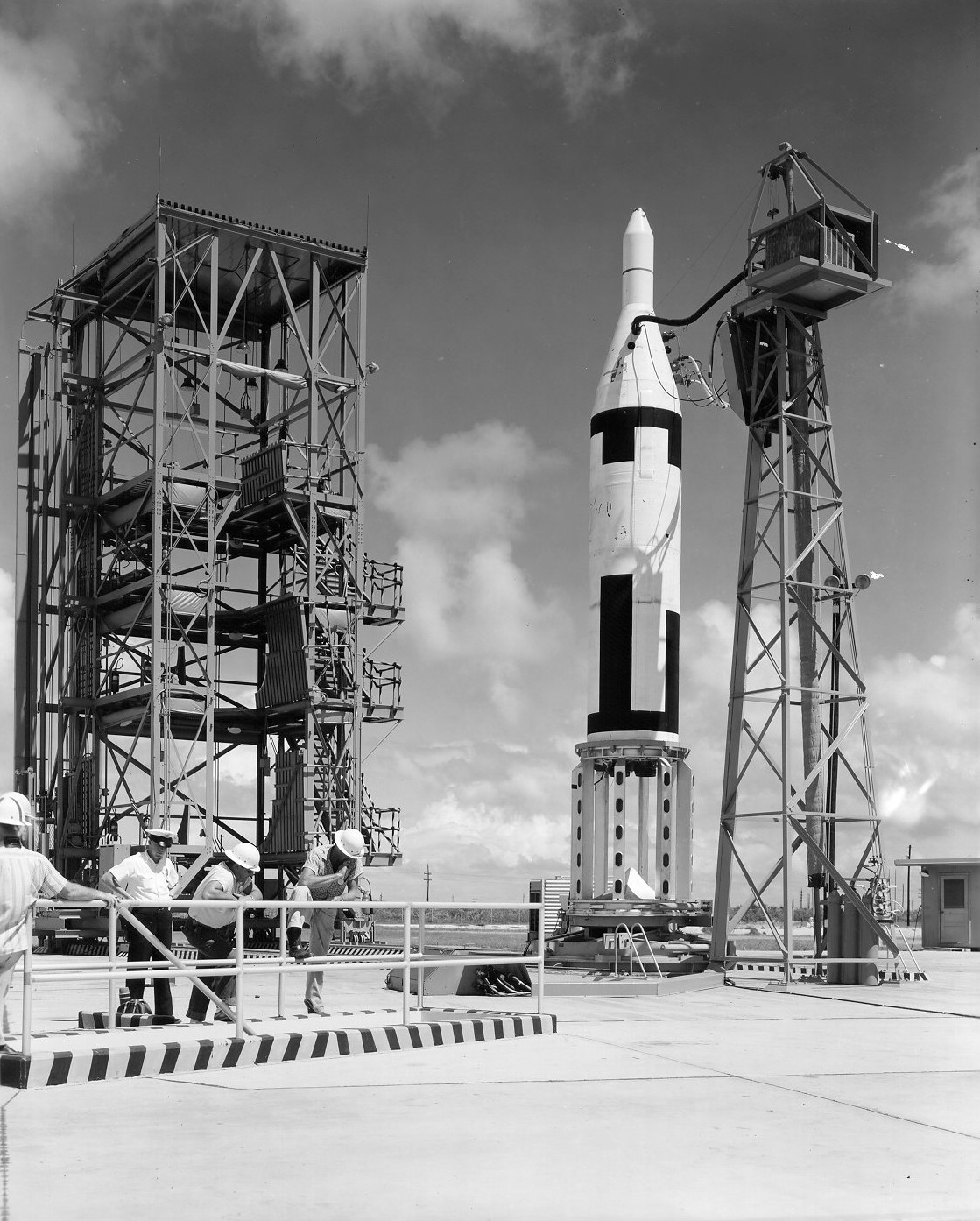
Polaris A1 on the pad during a test
Lockheed was responsible for the Polaris A1 missiles that George Washington carried. Each was 28.5' long and weighed about 29,000 lb, with two solid-propellant stages to propel the warhead to the target. These were the beneficiaries of a great deal of work on solid rocket propellant, which drew on the expertise of the American plastics industry1 to provide binders for the ammonium perchlorate and aluminum that provided most of the energy. The A1 was in many ways a prototype rushed into operational service, and insiders expected that reliability wouldn't be particularly good if they had to actually fire them, particularly because of electrical problems. Its 1,200 nm range was also short of the desired 1,500 nm, but it was enough to reach Leningrad from the Norwegian Sea, even if Moscow would have required a more hazardous trip into a small slice of the Barents Sea.2 To ensure that it actually got to the target, each of the four nozzles on each stage was fitted with a device known as a jetevator, which was essentially a ring around the bottom of the nozzle that could be swiveled to divert the thrust. The second stage also had another serious problem to deal with. Unlike liquid-fueled rockets, solid rockets essentially can't be shut down after they're lit, which is less than ideal for a weapon that is designed to place a warhead on a very specific trajectory. The solution was a set of pyrotechnic plugs in the front wall of the second stage, which would be triggered right after the warhead separated, neutralizing the thrust from the nozzles.
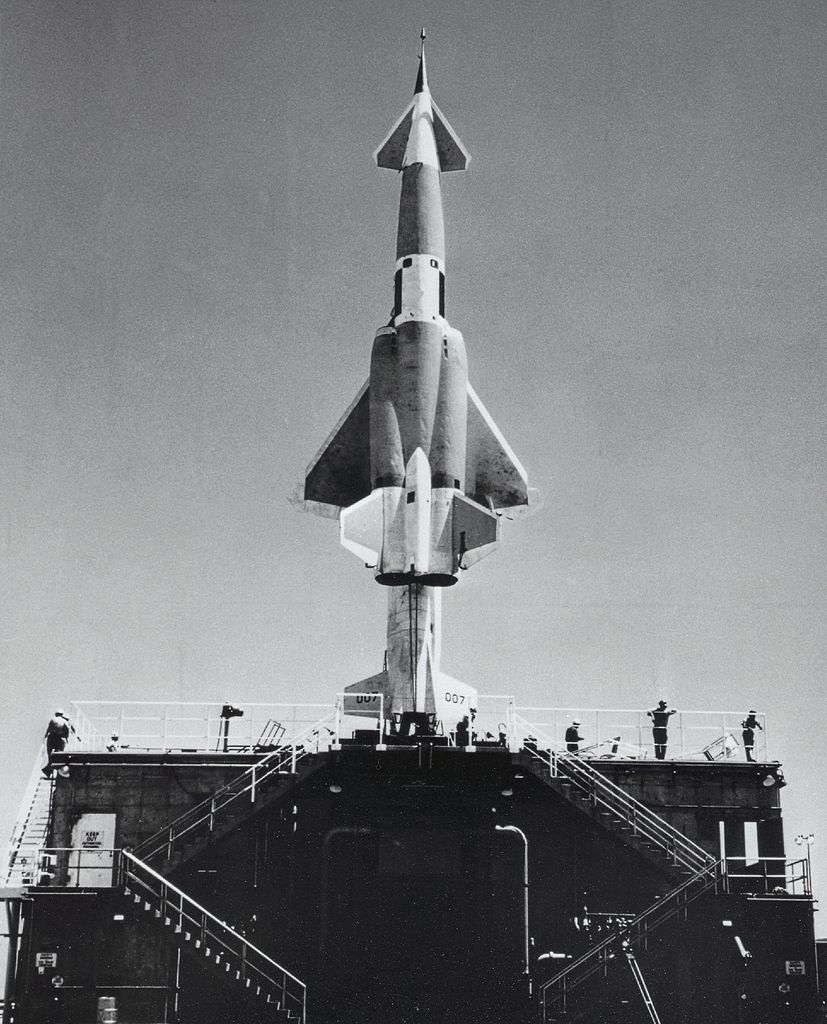
An SM-65 Navaho, the source of the SINS for Polaris
A much bigger problem than steering was figuring out where to go. This problem had been more or less solved for land-based ballistic missiles by the mid-50s, but Polaris posed two serious challenges of its own. The first was that, unlike land-based missiles, it was fired from a moving platform, which had to know where it was at all times. The solution was the Ship Inertial Navigation System (SINS), a collection of incredibly precise gyroscopes that would integrate the motion of the ship to keep track of its position without reference to the outside world. Two different teams competed for this, one from North American Aviation and one led by Charles Stark Draper of MIT. They had very different approaches to the problem, with Draper proposing a system that kept its orientation fixed relative to the stars at all time, while the North American team's system, originally developed for the Navaho cruise missile, kept itself level relative to local gravity. In practice, North American's system proved superior, as it didn't have to worry about tiny imperfections in the gyros having different effects as the platform rotated throughout the day.
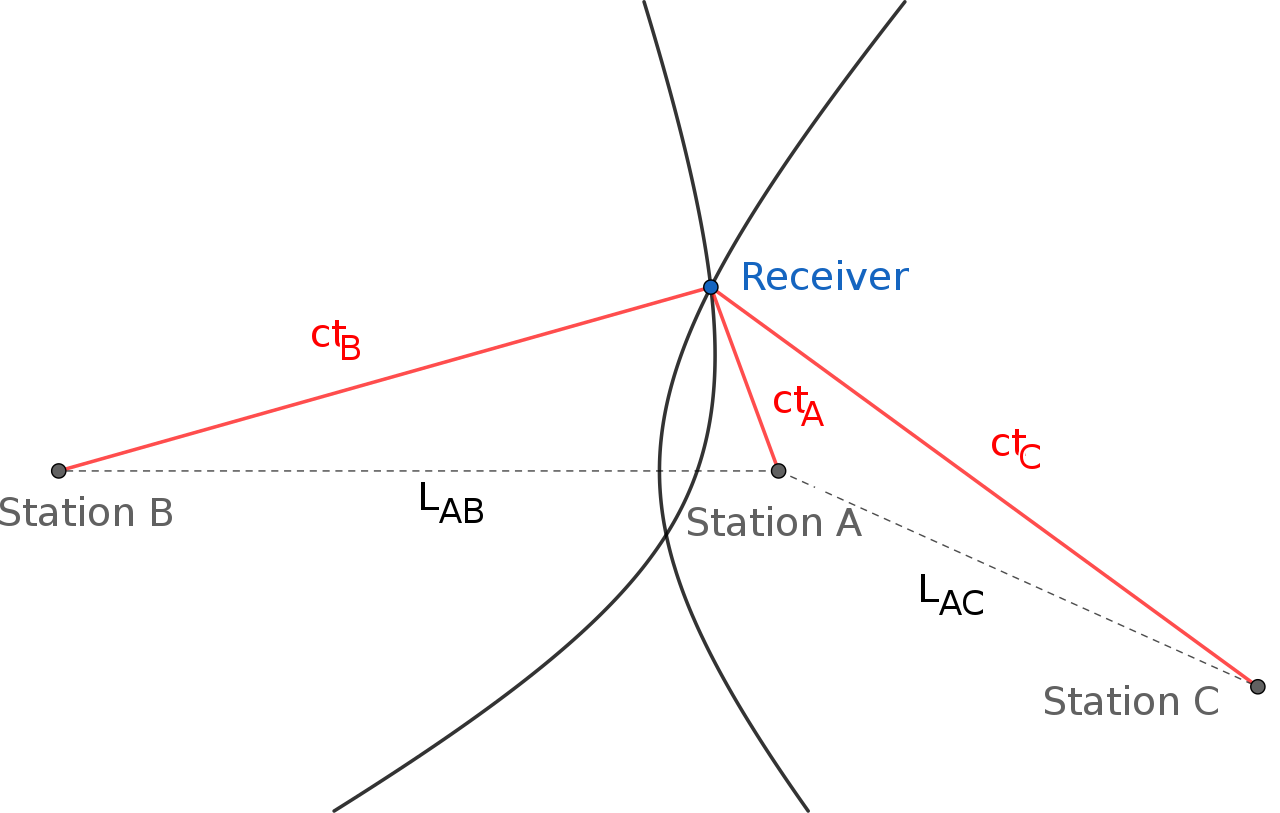
Hyperbolic navigation, like Loran-C
But even a really good SINS was going to have some imperfection, and thus the position it reported would slowly "drift" from the true position. Some means was needed to update it, and several solutions were proposed. The first was to take star sightings using a special periscope, but this proved exceptionally difficult, and they were removed by 1969. The next was to carefully map the patrol areas the SSBNs would use, so they could use sonar to find underwater features and update their position that way. New and much more precise surveys would be needed, and the work required would also be helpful in producing high-quality gravity maps, which were necessary for missile accuracy. But the survey ships themselves needed some way to navigate accurately, which was provided by a system known as Loran-C. Loran-C involved a series of land-based stations transmitting timed radio signals. By comparing the difference in time signals from three or more stations, a receiver could work out where it was to within a quarter-mile or less. The submarines were also equipped to use Loran-C, but the ground stations were obviously vulnerable to Soviet attack and less obviously vulnerable to political attack when their purpose began to leak a few years later.
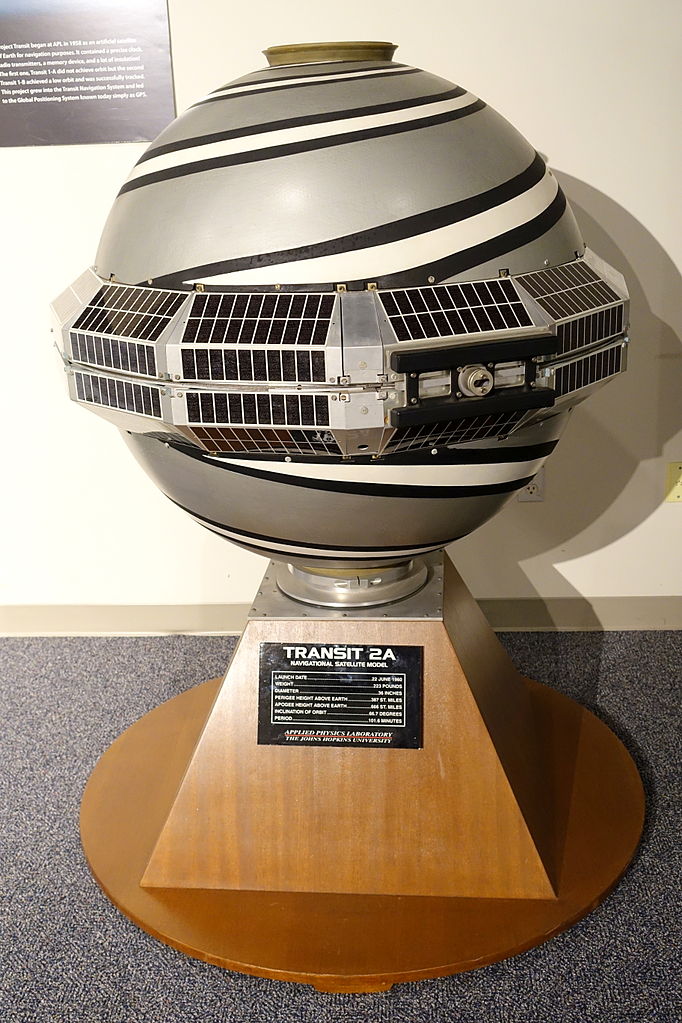
A model of a Transit satellite
The ultimate solution was to be found in space, where the Navy established a system known as Transit, the forerunner of today's GPS. Unlike GPS, Transit was able to find its location from a single satellite, based on the time and orbital position signals broadcast by the satellite as it went overhead in low orbit. It did this using the doppler effect on the satellite's signal as it went by, which was unique to each location on Earth. A specialized computer, the UKY-1, had to be developed, as no existing computer could fit through a submarine's hatch. Using a 2-minute Transit pass, it could produce a location within about 15 minutes that was accurate to within 20 m or so. Tracking the Transit satellites from ground stations yielded much better models of the Earth's gravity field, further improving the ultimate accuracy of the missiles.

Me and a friend outside Draper Labs in Cambridge, Massachusetts
But all of this was only enough to find the submarine's position at launch, and still didn't solve the problem of getting the missile from there to the target. Obviously, the guidance in this case would have to be inertial, a system similar to SINS, but much smaller and lighter and hooked to a computer which could produce corrections in real time to put the missile on the right trajectory. This time, the contract went to Draper's team, who proposed using a method known as Q-guidance. This involved using a series of pre-calculated matrices which greatly simplified the math that had to be done onboard. In fact, these matrices were so complicated that the first generation of submarines couldn't even carry a computer to calculate them. Instead, they went to sea with decks of punch cards produced ashore, with slight corrections calculated onboard for the precise location of the submarine. A specialized digital computer, designed only for the Q-guidance calculations, was fitted to each missile and would update the steering based on the data it got from the inertial platform. It had 400 discrete gates, about as many as a digital watch, and was the first digital guidance system for any missile. The whole guidance system weighed 225 lb, and was a nightmare to produce and use. It had to be optically aligned, with a light beam from the SINS passing down the middle of the submarine's missile compartment. The entire system was expected to be able to deliver the warhead to within 2 nm or so of the target.
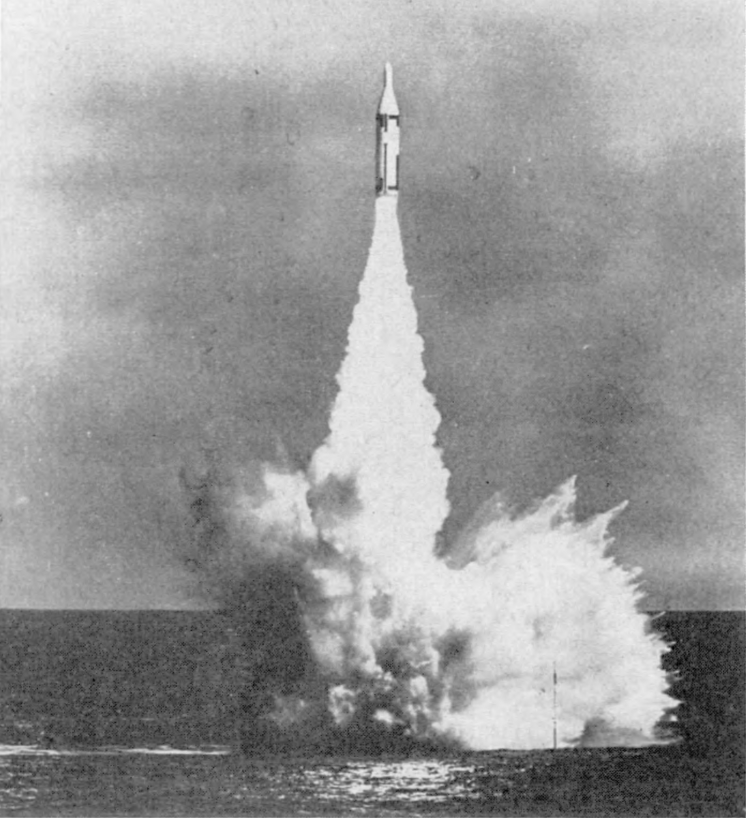
An early Polaris test launch
This would be more than adequate against the cities that Polaris was designed to kill, as each missile carried a W47 nuclear warhead with a yield of around 600 kT. The W47 was as innovative as any other part of Polaris, weighing only 600 lb, less than half the weight of most contemporary warheads. Its designers at Livermore Labs achieved this via a number of new features, most notably the first use of a 2-point linear implosion system, which greatly cut the weight of the firing system relative to earlier multi-point designs. This also took advantage of improved computing power, which allowed for far greater efficiency by simulating the warhead in 2 dimensions. But the W47 was not without its problems. Most were simple reliability concerns, but the biggest was revealed in a one-point safety test3 just before the 1958-1961 test moratorium went into effect, which had a 100-ton yield. To make sure that this wasn't a problem on operational weapons, Livermore designed a mechanical safety system. A boron-cadmium wire was placed in the center of the weapon's primary "pit", with a motor that would wind it out when the weapon was properly armed. If one point detonated before then, there would be no yield, as both boron and cadmium are effective neutron absorbers. Unfortunately, this stopgap was found to have dire consequences a few years later, as the wire would react with the plutonium and get stuck, rendering the warhead a dud. In the late 60s, the W47 was redesigned to overcome this problem, and tests finally showed it to be inherently one-point safe. Another concern was what would happen if the pit was flooded with seawater, a neutron reflector, which could make it critical and cause a small explosion.4 A test of this scenario, known as Project Stardust, was carried out in 1960, and ultimately showed that the warhead was safe in this configuration.5
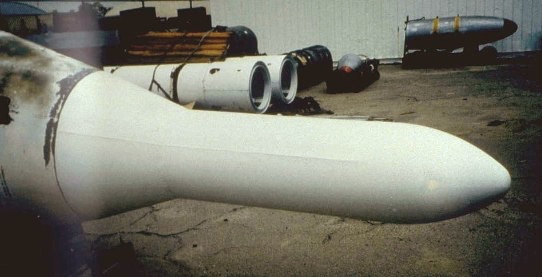
The RV for the W47/Polaris
Most earlier ballistic missiles had seen their reentry vehicles developed separately from the warhead, which meant that the warhead was usually only about half of the final payload weight. The SPO realized that integrating the two would allow for major weight savings, and the RV itself weighed only about 250 lb. It used a beryllium heat sink to keep the warhead cool during reentry, which also served as the outer case of the bomb, saving a great deal of weight. The heat sink approach was also selected because it would require less flight testing than the alternative ablative approach, which has since become standard. The RV was flared at the base to provide aerodynamic stability, and spun by a pair of small rocket motors to even out the effects of any aerodynamic irregularities during entry. One drawback was that it was likely to be rather slow by the time it reached the ground, passing through the sound barrier at around 14,000', which potentially left it vulnerable to defending SAMs.
But the missile and even George Washington herself were only a small part of the system that the SPO built up for Polaris. A single submarine couldn't stay on station forever, which meant that more would have to be built. We'll take a look at the later SSBNs next time.
1 The Soviets, uninterested in consumer products, lacked such expertise and took much longer to switch to solid-fueled long-range missiles as a result. This same dynamic would play out two decades later, when the US was able to harness its civilian computer industries to build smart weapons in numbers the Soviets couldn't match. ⇑
2 I have maps of the potential patrol areas with Polaris A1 for Leningrad and Moscow. As far as I know, none of the Polaris boats ever entered the Baltic, which is not a good place for nuclear submarines. Weirdly, most of the focus seems to have been on the threat from that direction, not the Barents. ⇑
3 Basically, this was a test to see what would happen if one of the two detonators used on the warhead was set off. ⇑
4 This was a concern for many other weapons. There were serious worries about what would happen if the B-29s carrying Little Boy and Fat Man had to ditch. ⇑
5 The W47 was by far the most troublesome of America's nuclear weapons, primarily because of the frantic rush to get it tested before the moratorium and into service with Polaris. It was also later found to be very vulnerable to damage by neutrons from nearby nuclear weapons, a problem solved with a wrapping of boron-doped plastic. ⇑

Comments
45 for freedom! Later 42 due to budget cuts.
How is that meant to work?
@mycelium
No, it was 41 for Freedom. That post is going up Wednesday.
@Anonymous
I'm not sure exactly what you mean. The Soviets would attack by bombing. The political attack is the locals in a place like Japan (where this happened) realizing that it was a support system for Polaris instead of an innocent navigation system and asking that it be removed.
It's kind of weird that the super advanced nuclear submarine and missile navigation system is made to look like a medieval cross-staff and lodestone by the system I casually carry around in my pocket.
Well, not today, I left it at home today.
Which I suppose nuclear submarines would not do.
Or at least so I would have guessed. Then I read the bit about the warhead safety catch getting corroded in place and I wonder...
"The political attack is the locals in a place like Japan (where this happened)" I never realized the CPJ had that kind of political heft.
@ike
I don't think it was the communists. It was just anti-nuclear elements, which are not particularly hard to find in Japan.
@Doctorpat
That's a good point.
IIRC, the CPJ has and had no real influence in Japanese politics, but as bean mentions, anti-nuclear elements have some heft, especially when LORAN-C's presence makes nuclear attack from the Soviets a real possibility.
Tim Dodd (Everyday Astronaut) made a short video about the SM-64 Navaho: The weirdest rocket ever: The SM-64!